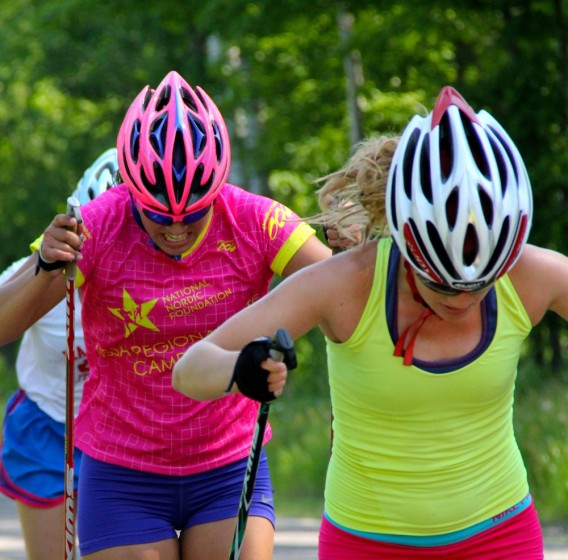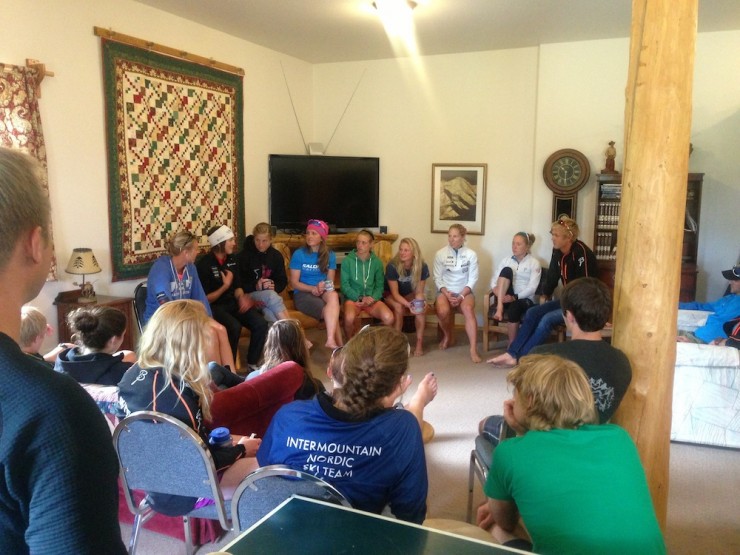
There is an agility test that junior skiers take every summer when they attend a Regional Elite Camp in the East, West, Central or Alaska regions. The test was first implemented three springs ago when coaches across the country saw a need to develop technique and agility in young skiers. They added an obstacle course that summer to the other strength and general fitness tests already on the camp schedule; if athletes could quickly and successfully move around cones on rollerskis, it would eventually translate to better racing down the road in the way of tactical competency in mass starts and more skilled navigation through a tightly grouped field.
The last of four REG camps held throughout the U.S. wrapped up last week, in Alaska, and the agility test that once challenged junior skiers now has to be made more difficult in order to push the ability levels of the skiers who show up. A backwards skiing section was added this year to a course that also includes tight corners on pavement and an off-road segment.
“I remember the first year, [the agility test] was pretty eye-opening,” said U.S. Ski Team development coach Bryan Fish said on the phone this week from Park City, Utah. “Now the athletes are getting used to it.”
The need for a tougher agility test at REGs is part of a larger upward trend being seen in junior skiing nationwide. As a specific example, Fish says he has noticed improvement in close-quarters skiing over the past few years amongst the juniors he observes in competition at World Junior and U23 Championships.
“When I go to junior worlds and see a mass start or sprinting, our athletes are moving through the field better tactically and technically,” he said. “Yeah, we’re seeing increase in performance.”

Fish recently returned from Anchorage, Alaska, where the last of the four REG camps concluded last week. REG camps are a cooperative development effort between regional and club coaches and the U.S. Ski and Snowboard Association — the camps run by the regions and supported by USSA — and their end goal is to help make the U18 and U20 skiers who attend into better athletes. Athletes are invited to work with area coaches in group workouts, testing and some seminars based on their Junior National results and national ranking.
“Our goal is to get athletes together more frequently and learning from one another,” Fish said. “That’s how they get better. That’s why we do international competition: they get pushed and hopefully rise to the occasion. Through experience both in camps and competition, that’s how we’re seeing our progress.”
Fish attended three out of the four camps this summer, and fellow USST coaches Jason Cork and Matt Whitcomb took part in the fourth. At each location Fish says he and his colleagues saw clear athlete progress across several categories, which he takes as measurements of successful camps.
In addition to requiring a harder agility test, athletes generally scored higher in the REG general strength test. Most of the juniors who qualify for an international trip last winter have attended an REG or one of the other steps in USSA’s development pipeline, which includes the National U16 Camp, REGs, the National Elite Group and the National Training Group. And at those higher steps, more athletes are being engaged: where participation was once around 50% for the NEG and NTG projects, it has risen to around 70%.
Fish also estimates that more area coaches have volunteered at camps each year, contributing to more collaboration between clubs and a better learning experience for the coaches who then return home to work with own teams.
“Every year we get more coaches partaking in these camps, and that’s something we’ve been pushing for — not just athlete participation, but also us as coaches,” Fish said. “Getting together and sharing ideas and working together.
“Clubs, coaches and regions are critical in working with our athletes on a daily basis and that is where a great deal of the work is done.”
What’s driving such progress? In part, Fish thinks it’s the camps themselves. Four years ago, on top of adding an agility test to REGs, coaches created the National U16 Camp (formerly known as the National J2 Camp) as another way to improve junior athlete development nationwide. It was the brainchild of Rick Kapala, Janice Sibilia, Ali (Dienes) Sehnert and Josh Smullin, who have since directed the camp each year.
Fish believes the addition of another step to the national development pipeline has been a critical part of growing junior success in the U.S. Every one of the juniors who qualified for the U18 trip to Norwegian Junior Nationals last winter, for example, had been through the J2 camp. On that trip, the U.S. girls turned heads with a silver medal in the relay.
“This’ll be the fourth year of the U16 camp…and I remember rolling into where the first one was, in Houghton, and questioning whether that age group was appropriate to have a national camp,” Fish said. “And when I walked away I had no question it was a very good step.”
No small amount of credit goes to the National Nordic Foundation, the non-profit that raises hundreds of thousands of dollars every year to help defray the costs of travel to camps and international competition for nordic athletes from the junior level through the World Cup team.
“NNF is instrumental in financial support and their involvement in development projects has allowed the growth and support of many of these projects,” Fish said.

He also thinks the presence of stronger role models for young American skiers have directly and indirectly influenced stronger junior skiing. The U.S. has been steadily improving on the World Cup for several years now, and this winter a World Championship gold medal became a feasible end goal for aspiring American skiers, courtesy of Kikkan Randall and Jessie Diggins.
“With the path that’s being put forth by our camp and competition structure, our goal, along with what our U.S. Ski Team athletes are doing, is providing this clear path that these athletes can actually see from an American standpoint, from an American example,” Fish said. “Here are the steps and those are the athletes that are actually doing it on an international stage. It’s very powerful to have that as an actual example instead of just being theoretical — something that is very tangible, that these juniors can truly see happening.”
In a direct way, USST athletes were a resource to juniors at REGs. At the East, West and Alaska camps, local national team members took part in group workouts and gave presentations outside of training, and Jessie Diggins made a video for the Central REG. In Stratton, Vt., Andy Newell, Sophie Caldwell, Diggins and Simi Hamilton joined the juniors. In Park City, Noah Hoffman and Liz Stephen joined the Western REG. In Alaska, most of the U.S. women’s team, plus Erik Bjornsen and international guests Astrid Jacobsen and Bettina Gruber, gave talks to the juniors gathered in Anchorage.
The development pipeline is designed to challenge juniors incrementally and allow them to thrive at each step of the way, with World Cup, World Championship and Olympic success held as the goal at the end of the ladder. After a few years of regional and club coaches tinkering with the intermediate rungs, Fish thinks most of the right elements are finally there for effective development nationwide.
“Just last year, [we started] this brand new Norwegian Junior National partnership, where we had Norwegians at our Junior Nationals and we sent some to theirs,” Fish said. “I feel we’re finally to a point where we have the pieces in place, and then it’s just continuing to be innovative and look at the quality of these steps.”
The next step, Fish says, is to further develop a national competition calendar that fosters stepwise athlete development. The SuperTour calendar, as it happens, is being revamped this summer.
“They’re looking at the SuperTour calendar and looking at these steps, but I feel there’s more we can do there,” Fish said. “But it’s just this whole building process, and I think we’ve been doing a better job of putting in these tangible steps.
“Providing those steps and additional opportunities is one of those pieces…that has provided these athletes with the opportunity to get together with higher frequency,” he continued. “Athletes learn from one other and motivate one another, and create a strong team culture, but it also gives us coaches another opportunity to work together and share ideas. But the bottom line is we’re trying to provide experience [to] our athletes. With more experience comes stronger performance.”
Audrey Mangan
Audrey Mangan (@audreymangan) is an Associate Editor at FasterSkier and lives in Colorado. She learned to love skiing at home in Western New York.



